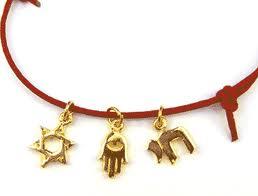Wearing a thin red string (as a type of talisman) is a custom, popularly thought to be associated with Judaism's Kabbalah, to ward off misfortune brought about by an "evil eye". In Yiddish the red string is called a roite bindele.
The red string itself is usually made from thin red wool thread. It is worn, or tied, as a type of bracelet or "band" on the left wrist of the wearer (the receiving side).
Some red string is brought from Israel. Sometimes, the string has been wound in large quantities around the tomb of the Hebrew Biblical matriarch Rachel, near Bethlehem. It is considered to have great powers of "good fortune" and grant added divine protection to those who wear it. Most rabbis though do not encourage the practice of this "segulah".
On the Ohr Somayach, Jerusalem yeshiva site, the "ask the rabbi" column says:
...There is no written mention in the Torah, Halachah or Kabbalah about tying a red string around the wrist. However, it seems to be a custom that has been around for some time, and may be based on Torah or Kabbalistic ideas. If there is any validity to the custom, it would be considered a segulah or protective type of act...There are sources for such special properties of seguloth. The Torah states, "The Lord your God has chosen you to be His Am Segulah (treasured people) out of all the peoples upon the face of the earth" (Deut. 7:6). Why are the Jewish people called G-d's segulah? Rabbi Chaim of Voloshzin says it's on account of the Torah and mitzvoth that have a miraculous effect on them, enabling their prayers to be answered in a special way. In fact, the mitzvoth themselves are protective: Charity protects from natural death, sanctifying the new moon protects from unnatural death, the succah protects from exile, and so on.
Therefore a custom that is based on Torah ideas or mitzvoth may also have special segula properties on a smaller scale. Regarding the red string, the custom is to tie a long red thread around the burial site of Rachel, the wife of Jacob. Rachel selflessly agreed that her sister marry Jacob first to spare Leah shame and embarrassment. Later, Rachel willingly returned her soul to God on the lonely way to Beit Lechem, in order to pray there for the desperate Jews that would pass by on their way to exile and captivity. Often, one acquires the red string when giving charity.
Perhaps for these reasons the red thread is considered a protective segula. It recalls the great merit of our matriarch Rachel, reminding us to emulate her modest ways of consideration, compassion, and selflessness for the benefit of others, while simultaneously giving charity to the poor and needy. It follows that this internal reflection that inspires good deeds, more than the string itself, would protect one from evil and harm.


